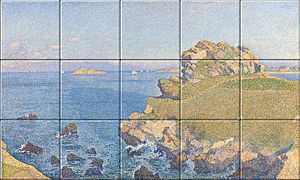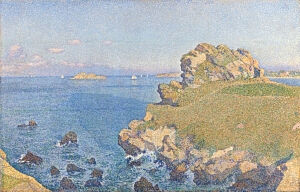We use cookies to make your experience better. To comply with the new e-Privacy directive, we need to ask for your consent to set the cookies. Learn more.

Theo Van Rysselberghe
Shop nowThéophile "Théo" van Rysselberghe (23 November 1862 – 14 December 1926) was a Belgian neo-impressionist painter, who played a pivotal role in the European art scene at the turn of the century.
Born in Ghent to a French-speaking bourgeois family, he studied first at the Academy of Ghent under Theo Canneel and from 1879 at the Académie Royale des Beaux-Arts in Brussels under the directorship of Jean-François Portaels. The North African paintings of Portaels had started an orientalist fashion in Belgium. Their impact would strongly influence the young Théo van Rysselberghe. Between 1882 and 1888 he made three trips to Morocco, staying there a total of one year and half.
Barely 18 years old, he already participated at the Salon of Ghent, showing two portraits. Soon afterwards followed his Self-portrait with pipe (1880), painted in somber colours in the Belgian realistic tradition of that time. His Child in an open spot of the forest (1880) already departs from this style and he sets his first steps towards impressionism. Yet soon he would develop his own realistic style, close to impressionism. In 1881 he exhibited for the first time at the Salon in Brussels.
After 1903, his pointillist technique, which he had used for so many years, became more relaxed and after 1910 he abandoned it completely. His strokes had become longer and he used more often vivid colours and more intense contrasts, or softened hues. He had become a master in applying light and heat in his paintings. His Olive trees near Nice (1905) remind us of the technique used by Vincent van Gogh. These longer strokes in red and mauve become prominent in his Bathing ladies under the pine trees at Cavalière (1905)
After some prospecting, touring on his bike, together with his friend Henri-Edmond Cross, of the Mediterranean coast between Hyères and Monaco, he found an interesting spot in Saint-Clair (where Cross already resided). His brother (and neighbour), the architect Octave van Rysselberghe, built him there a residence in 1911. He retired now to the Côte d'Azur and became more and more detached from the Brussels art scene.
Here he continued painting, mostly landscapes of the Mediterranean coast, portraits (of his wife and daughter, and of his brother Octave). In 1910 he received an order for some large decorative murals and flower compositions for the residence of the family Nocard in Neuilly, France.
From 1905 on, the female nude becomes prominent in his monumental paintings : "After the bath" (1910). His painting The vines in October (1912) is painted in lively colours of red, green and blue. One of his last works was Girl in a bath tub (1925).
At the end of his life, he also turned to portrait sculpture, such as the Head of André Gide.
He died in Saint-Clair, Var, France on 14 December 1926 and was buried in the cemetery of Lavandou, next to his friend and painter Henri-Edmond Cross.




